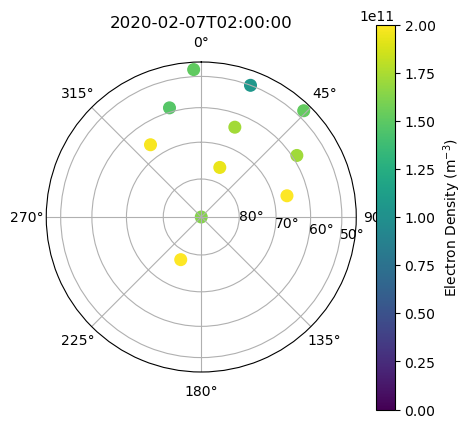Common Plots#
The following examples show how to create some common visualizations of AMISR data. Due to the 4D nature of the data, it is challenging to visualize all parts of the FoV simultaneously.
import h5py
import os
import urllib.request
import numpy as np
import matplotlib.pyplot as plt
Download files that will be used in this tutorial.
# Download the file that we need to run these examples
filename = 'data/20200207.001_lp_5min-fitcal.h5'
if not os.path.exists(filename):
url='https://data.amisr.com/database/dbase_site_media/PFISR/Experiments/20200207.001/DataFiles/20200207.001_lp_5min-fitcal.h5'
print('Downloading data file...')
urllib.request.urlretrieve(url, filename)
print('...Done!')
RTI Plot#
Range-Time-Intensity (RTI) plots are a common way to look at how profiles of a parameter change in time.
The Most Basic#
with h5py.File(filename, 'r') as h5:
bidx = 0
rng = h5['FittedParams/Range'][bidx,:]
ne = h5['FittedParams/Ne'][:,bidx,:]
utime = h5['Time/UnixTime'][:,0]
time = utime.astype('datetime64[s]')
plt.pcolormesh(time, rng[np.isfinite(rng)], ne[:,np.isfinite(rng)].T, vmin=0., vmax=4.e11)
<matplotlib.collections.QuadMesh at 0x7f8c38de7fa0>
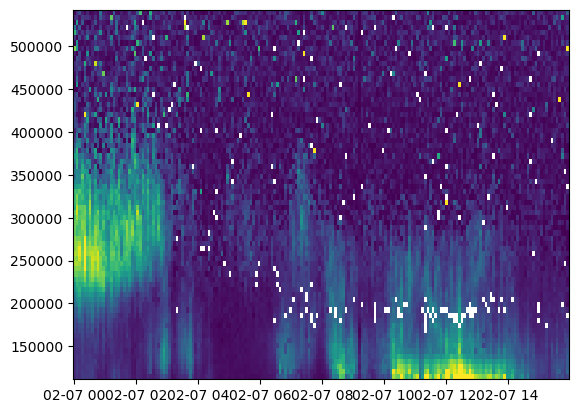
A Scientifically Useful Plot#
Now lets create the same plot as before but with intelligible axes and labels, a colorbar, ect. This is probably the minimum you want to do for inclusion in a paper or presentation.
with h5py.File(filename, 'r') as h5:
bidx = 0
rng = h5['FittedParams/Range'][bidx,:]
ne = h5['FittedParams/Ne'][:,bidx,:]
utime = h5['Time/UnixTime'][:,0]
time = utime.astype('datetime64[s]')
fig = plt.figure(figsize=(10,4))
ax = fig.add_subplot(111)
c = ax.pcolormesh(time, rng[np.isfinite(rng)], ne[:,np.isfinite(rng)].T, vmin=0., vmax=4.e11)
ax.set_xlabel('Universal Time')
ax.set_ylabel('Slant Range (m)')
fig.colorbar(c, label=r'Electron Density (m$^{-3}$)')
<matplotlib.colorbar.Colorbar at 0x7f8c38b3e8f0>
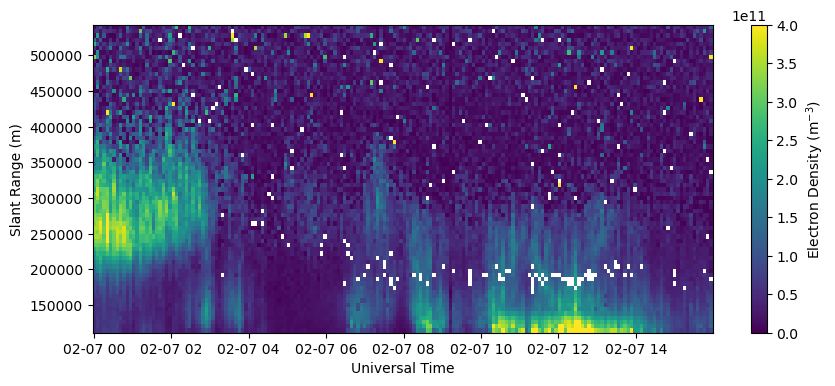
Plotting a Specific Beam#
Plot a specific beam by selecting the beam index (bidx) more carefully. You can either select a particular beam by its beamcode, or choose a beam based on proximity to a particular azimuth/elevation (i.e., choose the highest elevation beam in the beam pattern).
# Plot beam 64157
with h5py.File(filename, 'r') as h5:
beamcodes = h5['BeamCodes'][:]
print(beamcodes)
bidx = np.where(beamcodes[:,0]==64157)[0][0]
rng = h5['FittedParams/Range'][bidx,:]
ne = h5['FittedParams/Ne'][:,bidx,:]
utime = h5['Time/UnixTime'][:,0]
time = utime.astype('datetime64[s]')
fig = plt.figure(figsize=(10,4))
ax = fig.add_subplot(111)
c = ax.pcolormesh(time, rng[np.isfinite(rng)], ne[:,np.isfinite(rng)].T, vmin=0., vmax=4.e11)
ax.set_xlabel('Universal Time')
ax.set_ylabel('Slant Range (m)')
ax.set_title('Beam Number: {:.0f} (az:{:.1f}, el:{:.1f})'.format(beamcodes[bidx,0], beamcodes[bidx,1], beamcodes[bidx,2]))
fig.colorbar(c, label=r'Electron Density (m$^{-3}$)')
[[ 6.31970000e+04 -3.50900002e+01 6.61900024e+01 6.75000000e-20]
[ 6.32390000e+04 -1.62299995e+01 5.86800003e+01 6.54000000e-20]
[ 6.32810000e+04 -2.95000005e+00 4.75499992e+01 4.66000000e-20]
[ 6.33650000e+04 7.60899963e+01 6.61900024e+01 6.21000000e-20]
[ 6.34010000e+04 5.72299995e+01 5.86800003e+01 6.02000000e-20]
[ 6.34490000e+04 4.39500008e+01 4.75499992e+01 4.21000000e-20]
[ 6.40160000e+04 1.40400000e+01 9.00000000e+01 7.01000000e-20]
[ 6.40370000e+04 2.05000000e+01 7.60000000e+01 6.37000000e-20]
[ 6.40550000e+04 2.05000000e+01 6.40000000e+01 7.26000000e-20]
[ 6.40790000e+04 2.05000000e+01 5.00000000e+01 5.53000000e-20]
[ 6.41570000e+04 -1.54300003e+02 7.75000000e+01 4.45000000e-20]]
<matplotlib.colorbar.Colorbar at 0x7f8c387cd000>
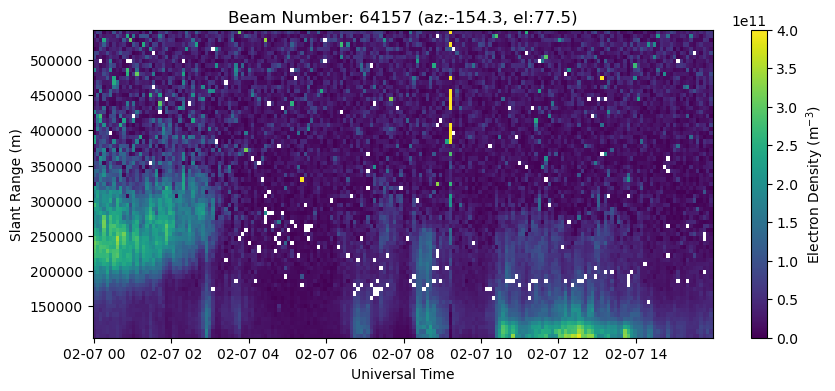
# Plot the highest elevation beam (vertical in this case)
with h5py.File(filename, 'r') as h5:
beamcodes = h5['BeamCodes'][:]
bidx = np.argmax(beamcodes[:,2])
rng = h5['FittedParams/Range'][bidx,:]
ne = h5['FittedParams/Ne'][:,bidx,:]
utime = h5['Time/UnixTime'][:,0]
time = utime.astype('datetime64[s]')
fig = plt.figure(figsize=(10,4))
ax = fig.add_subplot(111)
c = ax.pcolormesh(time, rng, ne.T, vmin=0., vmax=4.e11)
ax.set_xlabel('Universal Time')
ax.set_ylabel('Slant Range (m)')
ax.set_title('Beam Number: {:.0f} (az:{:.1f}, el:{:.1f})'.format(beamcodes[bidx,0], beamcodes[bidx,1], beamcodes[bidx,2]))
fig.colorbar(c, label=r'Electron Density (m$^{-3}$)')
<matplotlib.colorbar.Colorbar at 0x7f8c3869e890>
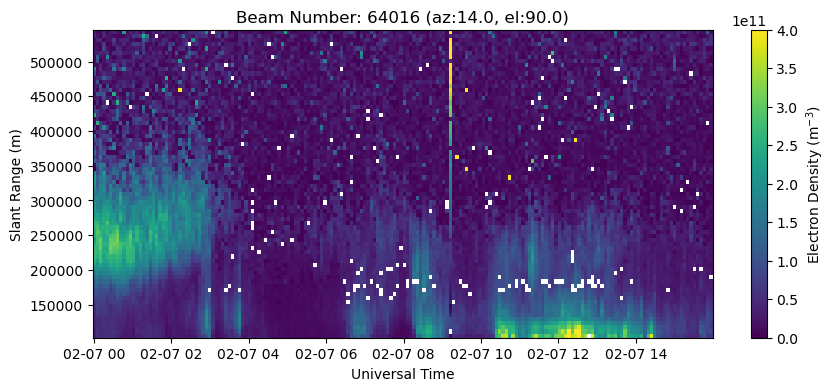
Beam Position Plot#
Create a polar plot of all beam positions for this particular experiment.
with h5py.File(filename, 'r') as h5:
beamcodes = h5['BeamCodes'][:]
az = beamcodes[:,1]
el = beamcodes[:,2]
# set up plot
fig = plt.figure(figsize=(5,5))
ax = fig.add_subplot(111, projection='polar')
ax.set_theta_direction(-1)
ax.set_theta_offset(np.pi/2.0)
ax.set_rlabel_position(100.)
elticks = np.arange(20., 90., 10.)
ax.set_rticks(np.cos(elticks*np.pi/180.))
ax.set_yticklabels([str(int(el))+u'\N{DEGREE SIGN}' for el in elticks])
ax.scatter(az*np.pi/180., np.cos(el*np.pi/180.))
<matplotlib.collections.PathCollection at 0x7f8c38bf4a60>

Beam Positions with Data#
Now plot the beams positions with density values for one timestamp. Because this is a 2D plot and each beam has many values at different ranges, you need to choose a characteristic value from each profile to plot. A simple way to do this is plot the range index that intersects your altitude of interest (say 300 km). Because range binning is done approximately in altitude, you can use the same index across most of the FoV, although this is not the most precise. Plot the density values of this slice at 2020-02-07 02:00:00 UT.
targalt = 300.*1000.
targtime = np.datetime64('2020-02-07T02:00:00')
with h5py.File(filename, 'r') as h5:
beamcodes = h5['BeamCodes'][:]
# get vertical beam index
bidx = np.argmax(beamcodes[:,2])
alt = h5['FittedParams/Altitude'][bidx,:]
# find range index that corresponds to the target altitude
aidx = np.argmin(np.abs(alt-targalt))
utime = h5['Time/UnixTime'][:,0]
# find time index that corresponds to target time
tidx = np.argmin(np.abs(utime.astype('datetime64[s]')-targtime))
ne = h5['FittedParams/Ne'][tidx,:,aidx]
az = beamcodes[:,1]
el = beamcodes[:,2]
# set up plot
fig = plt.figure(figsize=(5,5))
ax = fig.add_subplot(111, projection='polar')
ax.set_theta_direction(-1)
ax.set_theta_offset(np.pi/2.0)
ax.set_rlabel_position(100.)
elticks = np.arange(20., 90., 10.)
ax.set_rticks(np.cos(elticks*np.pi/180.))
ax.set_yticklabels([str(int(el))+u'\N{DEGREE SIGN}' for el in elticks])
c = ax.scatter(az*np.pi/180., np.cos(el*np.pi/180.), c=ne, s=70, vmin=0., vmax=2.e11)
ax.set_title(targtime)
fig.colorbar(c, label=r'Electron Density (m$^{-3}$)')
<matplotlib.colorbar.Colorbar at 0x7f8c38a5e530>
